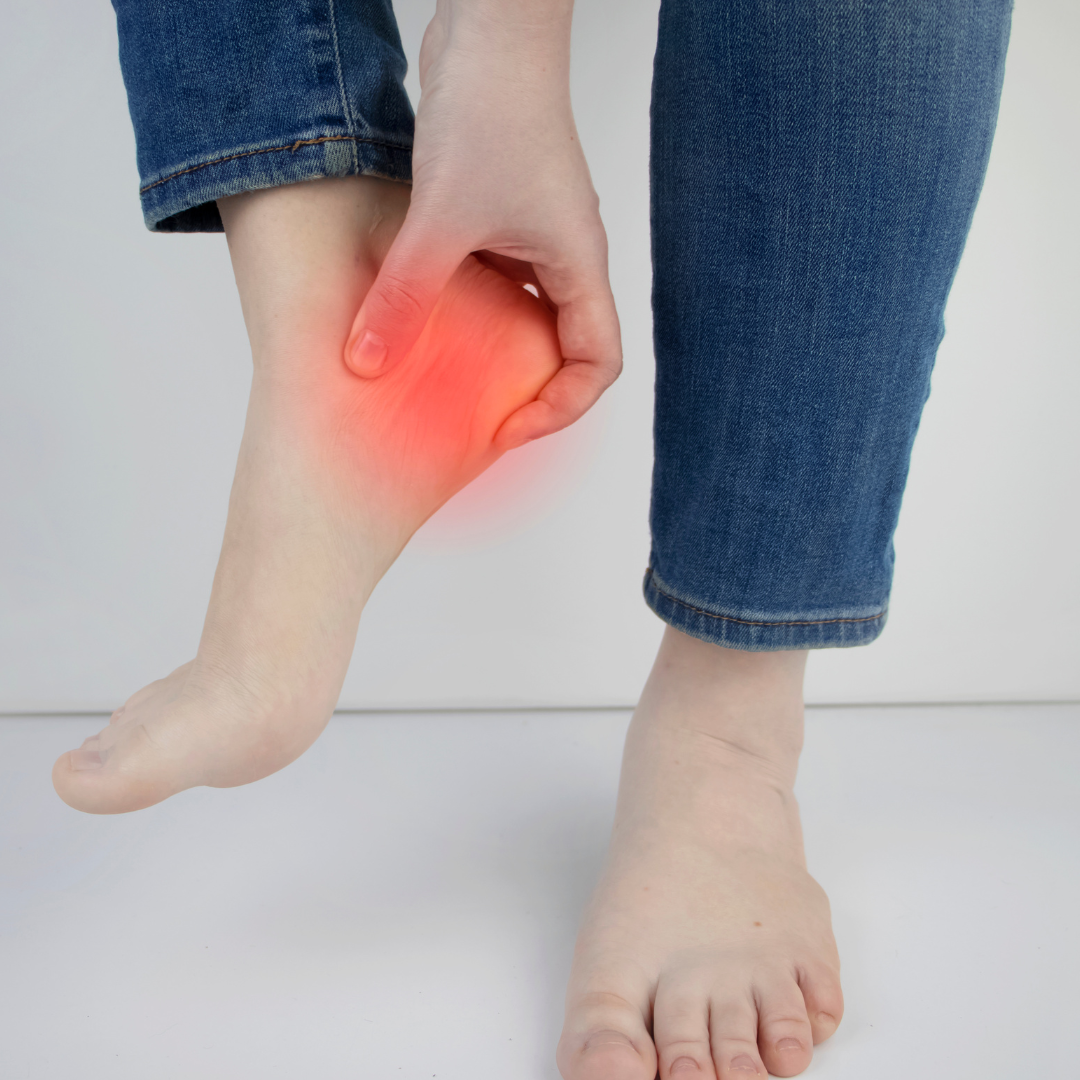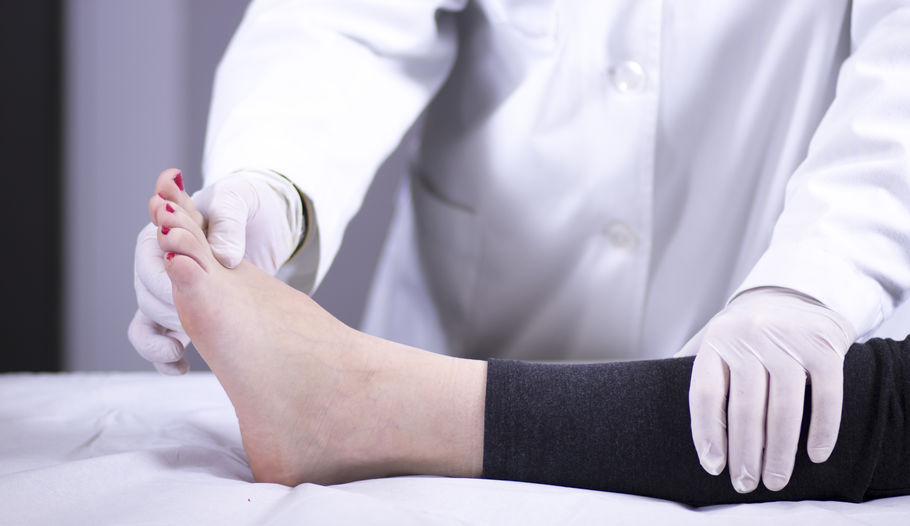-
Podiatric Medicine Brings Lasers Down To Earth

Lasers might seem like they belong in space, but they can actually be quite helpful here on the ground. At Kentlands Foot and Ankle Center, we think the therapeutic applications of lasers don’t get enough attention. With that in mind, we’ve put together a short blog post that explains just how great these high-tech systems can be from a podiatric point of view!
Laser Therapy: Fighting Fungal Toenails
- Stubborn, uncomfortable, and aesthetically unpleasant toenail fungus can recur again and again.
- We use the PinPointe laser system to penetrate the nail and exterminate fungus at the source.
- This non-invasive technique is successful, safe, and painless.
- As the first laser ever to be cleared for use by the FDA, it has a proven record of success.
Why Use Lasers?
- No drugs or side effects. Oral medications can alter liver enzymes, while topicals often take a year or more to work. Topical meds also have to be used twice a day if they’re going to have a chance at succeeding.
- They’re quick. PinPointe treatment will only take about 30 minutes.
- No recovery time or pain. The laser reaches under the nail areas without damaging the skin. You can walk in, have your treatment, and walk out on the same day. Once the fungus has been destroyed, new nail growth begins.
- Solid success rates. Many patients see perceptible improvements after just a single treatment, with clear nail growth stimulated right away.
PinPointe laser therapy is just one of many advanced medical methods we utilize at the Kentlands Foot and Ankle Center, where we’re always seeking the next innovation. In fact, we have other lasers we like to use! Different systems are employed for different purposes: We have a Remy Class IV Laser to treat issues like plantar fascitis, while Cold Laser Therapy helps with pain relief and nerve damage resulting from injuries. Lasers are a great option when you want to avoid the cost, pain, and prescription meds that go hand in hand with surgery.
A good laser can be your foot’s best friend. Come see for yourself! Dr. Jon Sherman always employs the most modern, sophisticated techniques available to offer his Gaithersburg patients top-quality podiatric care. Contact us today to schedule an appointment.
-
Running Shoes: Start Off on The Right Foot!

If you run, you need the right footwear. Fortunately, Kentlands Foot and Ankle Center is well-prepared to support your footwear needs. Before you decide which shoe is right for you, let’s break down some common tips that can improve performance and ensure sustainability.
Here are some Do’s and Don’ts to follow before purchasing new running shoes
DON’T run in old, beat-up shoes. Runners need to be prepared, and footwear is no exception. To keep shoes fresh, try to have two pairs on hand and alternate them. The wear and tear from repeated motions erodes the support of a running shoe, which might increase your risk of injury.
DO invest in a pair of good socks and laces. The right pair of socks will provide valuable cushioning and even help with sweating. Laces with ‘bumps’ along them might cost a little more, but they don’t slide around in your shoes.
DON’T ignore the unique traits of your feet. Do you have high, flat, or neutral arches? Do your ankles roll when you run? These are the kinds of details our experts can help you with, and knowing about them beforehand will help you choose the right shoes for you.
DO consider custom orthotics. These can enhance your running game by helping to prevent injuries before they occur. And we can help you find the perfect fit! At Kentlands, there are no more clunky plaster casts or lengthy waiting times. Instead, we employ our new 3D laser scanner to perform a clinical examination of your feet. In just 10 seconds, this technology takes thousands of measurements and provides the perfect custom fit.
We’re big fans of running, and we know just how much it can benefit your life. Still, putting safety first is important. Dr. Jon Sherman is an acknowledged expert in treating sports injuries, and he has served as a consultant for the Marine Corps Marathon. He’s well-equipped to help improve your athletic performance and keep your feet healthy as you chase your goals. To schedule a comprehensive foot examination with Dr. Sherman at our Gaithersburg office, please call 301-330-8971 or contact us online today.
-
Good News for People with Chronic Heel Pain!

A twitch of pain somewhere in your foot is one thing – brief and tolerable. Thank goodness it goes away.
Heel pain that doesn’t go away is an entirely different matter. We’re talking about the heel pain that greets you like a knife when you step out of bed every morning. The kind of intense pain that makes you cry out, perhaps with a few choice words you didn’t mean to say. This kind of pain requires attention from Kentlands Foot and Ankle Center’s board-certified podiatrist, Dr. Jon M. Sherman, because it’s not likely to get better on its own.
Plantar fasciitis, explained!
The medical term for chronic heel pain is plantar fasciitis. Any medical word with the suffix “-itis” means “inflammation.” In this case, it’s the plantar fascia that’s inflamed. The plantar fascia is a large, thick ligament that runs along the bottom of your foot, connecting the calcaneus (heel bone) to your toes. It’s easily inflamed under some circumstances:
- You have a job that requires you to be on your feet for much of the day, such as a waiter, nurse, or urban mail carrier.
- You’re a runner or walker who’s recently increased their mileage, pace, or distance.
- You participate in other athletic activities, such as ballet, that put a lot of stress on your feet.
- You’re carrying some extra pounds, which puts undue stress on your feet.
- You have pre-existing issues with your foot anatomy, such as flatfoot or high arches.
- You’re over 40: The older you are, the more likely you will develop plantar fasciitis.
The pain you don’t have to live with
Fortunately, we have many effective treatments that soothe the pain of plantar fasciitis. Dr. Sherman will likely start with conservative approaches, including taking a break from any activity that hurts, performing stretching exercises, icing, taking anti-inflammatory medications, wearing custom orthotics, and getting steroid injections. Often, the best treatment involves a combination of all these.
Other treatment options include non-invasive shockwave therapy (ESWT, laser light therapy/cold laser, and physical therapy. Surgery for plantar fasciitis is a possibility but not a common one.
The key to successful plantar fasciitis treatment is getting it promptly. Don’t wait. We encourage residents of Montgomery County to consult Dr. Sherman sooner rather than later for a full examination and assessment of their heel pain. Call 301-330-5666 or contact us online for an appointment at our Gaithersburg podiatry office.
-
Let This Year Be The End Of Your Foot Pain

As we welcome the new year, many feel motivated to take steps towards self-improvement. Some may begin by improving their daily routines, including increased healthy exercise habits. If you start a new fitness routine, be gentle with yourself, be consistent, and start slowly. Occasionally, heel pain can intensify when you begin a new exercise routine. Don’t let heel pain prevent you from moving forward with your 2023 fitness goals!
Heel pain (plantar fasciitis) may be one of the most common issues seen by podiatrists today. It’s a condition in which the band of tissue that stretches from your heel bone to your toes becomes inflamed, torn, or otherwise stressed from overuse. It is vital to get a complete exam and proper diagnosis if you experience heel pain.
Our specialists recommend using the following methods to resolve foot pain during the new year
- Follow simple stretches and exercise routines to strengthen the foot.
- Wear proper fitting shoes with arch and ankle support.
- Ice your heel several times a day to reduce uncomfortable inflammation.
- Rest your lower extremities.
- Use custom orthotics to alleviate chronic foot pain.
- Use an anti-inflammatory drug such as Ibuprofen and Naproxen to help with the pain.
- Call a podiatrist.
Certain people have an increased risk of developing plantar fasciitis or foot pain. Those people are:
- Between the ages 40-60
- Carry extra weight
- Have predisposed hereditary conditions
- Have tight Achilles tendons
- Wear non-supportive shoes or high heels
- Have an occupation that causes you to be on your feet for extended periods
The longer you have been experiencing the pain of plantar fasciitis, the longer it may take to help resolve the pain. To better determine the source of your heel pain and the best course of treatment, schedule a comprehensive foot examination with Kentlands Foot and Ankle Center podiatrist, Dr. Jon M. Sherman, at our Montgomery office. To schedule your appointment, please call our office at 301-330-5666.
-
Diabetes Awareness and Education

Did you know that more than 29 million Americans have diabetes? Even more frightening, one in four of those individuals are unaware of their condition.
Diabetes is a complex disease that requires daily self-management – making healthy food choices, staying physically active, monitoring your blood sugar, and taking medications as prescribed. Healthy lifestyle adjustments for individuals with diabetes can also help non-diabetic people transform their lives and increase overall health and wellness while also helping prevent a variety of health conditions later in life!
What is diabetes?
There are three main types of diabetes:
- Type 1 diabetes – This is when your body does not make insulin to take the sugar (glucose) from the foods you eat and turn it into energy for your body. If you have type 1 diabetes, you need to take insulin every day to live.
- Type 2 diabetes – This is when your body does not make or use insulin well. You might need to take pills or insulin to help control your diabetes. Type 2 is the most common type of diabetes.
Why is diabetes serious?
Diabetes can cause health problems such as heart attack or stroke, eye problems, nerve damage, kidney problems, foot problems, and teeth and gum problems. People with diabetes need to make healthy food choices, stay at a healthy weight, get physical every day, and take their medicines even when they feel good. It is a lot to do. It’s not an easy lifestyle for some, but it’s worth the benefits.
Diabetes and Your Feet
Foot problems most often happen when there is nerve damage, which is most often called neuropathy. This can cause tingling, pain, or weakness in the feet. It can also cause loss of feeling in the foot, so you could possibly injure it and not even know it. Poor blood flow or changes in the shape of your feet or toes may also appear. It is especially important for diabetes patients to take good care of their feet and see their doctor right away if you see any signs of foot problems.
If you are experiencing chronic foot pain or discomfort in your lower extremities, call our Montgomery office at 301-330-5666 and schedule an appointment with our board-certified podiatrist Dr. Jon M. Sherman or visit our website for more information. Please note that our office is currently open Monday, 10am-5:30pm, and Tuesdays and Thursdays, 10am-5pm.
-
What Is a Podiatrist?

Around the world, podiatrists pursue the advancement of the Podiatry field for everyone’s benefit, and, to better serve those who suffer from ankle and foot conditions. Your feet are vital to your everyday life. They permit you to walk 150,000 miles in your lifetime, which is equal to walking around the world six times! Foot issues can be debilitating; therefore, it is important to take care of your feet.
People may wonder why there is a branch of medicine that deals strictly with feet. It’s because foot problems are very common. A few of the most common issues people have with their feet include:
- Bunions
- Athlete’s foot
- Ingrown toenails
- Diabetic neuropathy
- Plantar fasciitis
- Corns
- Heel spurs
- Blisters
Education and Awareness
Our team of experts at Kentlands Foot and Ankle Center strive to elevate awareness about the importance of proper foot health. That is one of the reasons we wanted our patients to be able to access reliable and accessible information that pertains to the lower extremities. If you would like to get involved, you can help spread the word about podiatry and important foot health tips! When you’ve learned more about proper foot health, you can begin spreading the word and educating others. Start here:
- Read up on health conditions related to the feet, including information on keeping your feet healthy.
- Proper daily foot care involves activities like caring for your toenails and wearing the right shoes.
- Learn to maintain good foot health
- Have an in-person conversation or by using social media to discuss podiatry and foot health.
When To See a Podiatrist
Anytime you experience foot or ankle discomfort, changes in the appearance of your feet, abnormal growth(s), or have an underlying medical condition that affects your feet or ability to function. Symptoms are not always obvious and may even continue unnoticed. If you or anyone you know is experiencing one or more symptoms, it is time to see a podiatrist.
Schedule An Appointment
If you are experiencing chronic foot pain or discomfort in your lower extremities, call our Montgomery office at 301-330-5666 and schedule an appointment with our board-certified podiatrist Dr. Jon M. Sherman or visit our website for more information.
-
Preparing For Your Next Appointment

A doctor visit can be nerve-wracking, especially if this is your first time at a podiatrist’s office. But with some simple preparation, you can limit the anxiety you feel prior to your appointment and make the most out of seeing your specialist. At Kentlands Foot and Ankle Center, we take extra care in making sure your visit is as comfortable and helpful as possible! Below is a useful guide to help you prepare for your next appointment.
Before Your Visit
It might be helpful to make a physical or mental checklist of some important information to make your podiatrist’s questions easier to answer, such as:
- The symptoms you’re experiencing
- Any medication you’re taking
- Relevant lab test results
- Allergies they should know about
- Previous surgeries
- Any questions or concerns you have for your doctor
During Your Visit
- Expect your podiatrist to go over all the information listed above
- Be sure to ask for any clarification if you’re unclear with what your doctor is saying
- Take notes if you find it helpful
- If you’re attending a virtual appointment, be sure you arrive to your appointment on time and check that your technology is working properly
After Your Visit
- Make sure you follow your podiatrists’ recommendations for healing and recovery
- Pick up any medication your doctor may prescribe and take them as instructed
- Schedule a follow up appointment if necessary
- If your doctor has not gotten back to you with test results, give them a call
- Reach out to your podiatrist if you have any follow up concerns or questions
Schedule A Visit
It is recommended that you visit your local podiatrist once a year for an annual checkup. If you’ve been experiencing any foot or ankle pain, schedule an appointment with a podiatrist so they can examine and treat any problem you might be facing. To schedule an appointment with our board-certified podiatrist Dr. Jon M. Sherman, at our Montgomery County office, call 301-330-5666 or visit our website for more information.
-
Put Your Best Foot Forward

April is National Foot Health Awareness Month and it is also the perfect time to think about how much we count on our feet each day, and how important it is to develop healthy habits to keep them free of pain. According to the American Podiatric Medical Association, approximately 20 percent of the U.S. population has at least one-foot problem annually. At Kentlands Foot and Ankle Center, our podiatrist, Dr. Jon M. Sherman, is Board Certified in Foot Surgery by the American Board of Podiatric Surgery. Dr. Sherman is also a Fellow of the American College of Foot and Ankle Surgeons, all of which set him apart from other podiatrists.
Fun Facts About Feet
- Each foot is composed of 26 bones, 33 joints, and over 100 muscles and tendons.
- Together both feet contain 1/4 of the bones in the entire body.
- The average person, over their lifetime, will walk approximately the same distance as if they had walked around the earth 4 times.
- 5 times a person’s body weight is transmitted through each foot with every step!
How To Maintain Healthy Feet
Do:
- Try foot massages or reflexology.
- Soak your feet in Epsom salt if they are sore.
- Change your socks daily.
Don’t:
- Share footwear
- Wear poor-fitting shoes
- Try “DIY” fixes for your foot problems
When To Visit a Podiatrist
The field of podiatry strives to improve the overall health and well-being of patients by focusing on preventing, diagnosing, and treating conditions associated with the foot and ankle. It is time to see a podiatrist anytime you have foot or ankle discomfort, changes in the appearance of your feet, abnormal growth, an injury, or a medical condition that affects your feet. It is also very important to have an annual check-up with your podiatrist to maintain healthy feet.
To schedule an appointment at our Gaithersburg, MD office, please call (301) 330-5666 or visit our website for more information.
RECENT POSTS
categories
- Uncategorized
- Featured Articles
- Foot Disorders
- Broken Ankle
- Broken Toe
- Fracture
- Foot Health
- Foot Care
- Arthritis
- Foot Pain
- Skin Cancer
- Podiatry Appointment
- Custom Orthotics
- Podiatrist
- Diabetes
- Gout
- Heart Health
- National Nutrition Month
- National Foot Health Awareness Month
- Foot Safety
- Foot and Ankle Injuries
- Falls Prevention
- Chronic Heel Pain
- Shoes
- Laser Therapy
- Quoted
- Physical Therapy
- KeryFlex
- Sweat
- Summer Foot Care
- Sports Injury
- ESWT
- Fungal Toenails


